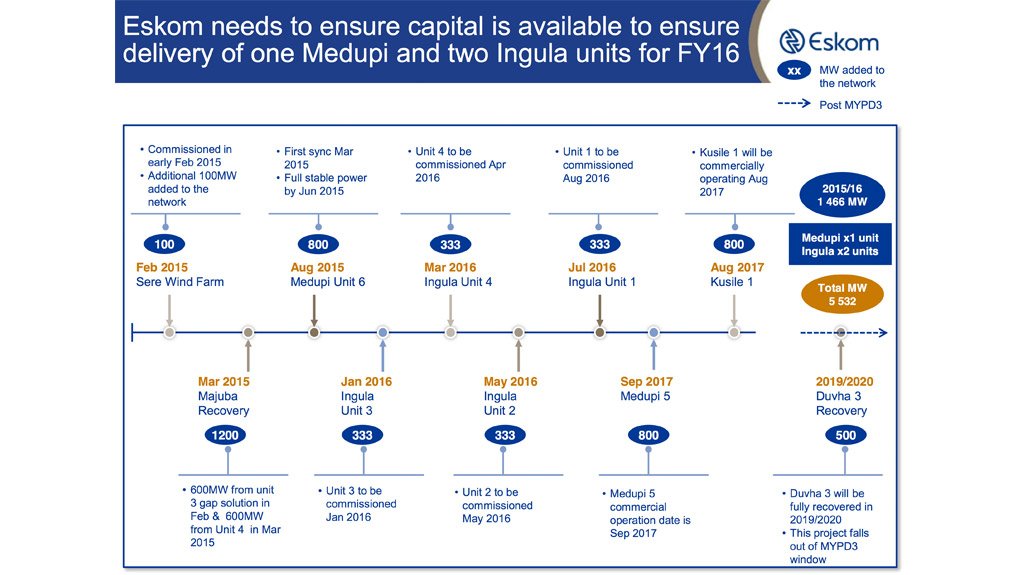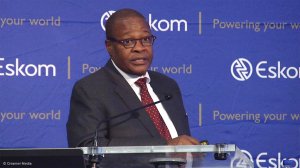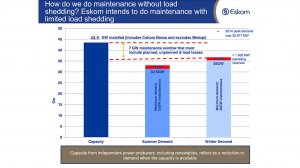State-owned electricity utility Eskom outlined a new operating philosophy on Wednesday with acting CEO Brian Molefe indicating that the strategy was based on finding the theoretical “sweet spot” that would enable it to conduct much-needed maintenance with “no, or minimal load-shedding”.
Speaking hours before yet another load-shedding episode at a presentation hosted to outline the winter prognosis, Molefe did not promise an end to confidence- and growth-sapping rotational power cuts, the risk of which would remain for 18 to 24 months. However, he said that, with the help of government’s electricity war room, Eskom had agree on a new strategy that sought to blend the ‘keeping-the-lights-on’ policy of the past, with the more recently adopted ‘maintenance-first’ operating model.
Drawing on a ‘production possibility frontier curve’ to explain the theoretical approach being pursued, Molefe said the generation business unit would seek to find that point along the convex curve that met both goals of “maximising maintenance, while keeping the lights on”.
“Keeping the lights on and doing maintenance appear to be contradictory, but I think it is possible to have them both as objectives.
“We have to find a point somewhere on the curve between keeping the lights on at all costs and not doing maintenance; or doing maintenance and switching off the lights – there is, I think, a sweet spot somewhere in the middle,” he explained.
Using the metaphor of a household budget, Molefe sought to explain the model thus: “If you have expenditure of R1 200, how can you survive on a budget of R1 000? Firstly, it is to recognise that the budget is R1 000 and second it is to prioritise expenditure in such a way that, at the end of the month, you can stay within the budget,” he explained, likening load-shedding to going into overdraft.
7 000 MW OUTAGE 'BUDGET'
For the current winter, Eskom expected daily demand to peak at around 35 500 MW (36 500 MW once a 1 000 MW operating reserve was included) against a theoretical dispatchable installed base of 43 500 MW.
It had, therefore, set a daily outage “budget” of 7 000 MW – 5 500 MW of which was considered planned maintenance, leaving only 1 500 MW for breakdowns. Achieving such a ratio would require a major change in the performance of the coal-fired fleet, where unplanned maintenance had increased materially since 2010, resulting in the energy availability factor falling to below 75%.
But Eskom’s “ticket” out of the current supply/demand imbalance lay primarily in ensuring delivery on its build programme, which was both delayed and over budget.
However, Medupi Unit 6 had been delivering 800 MW during the past few weeks and it was confirmed that it would enter full commercial operation from August.
In addition, an immediate solution had been found to ensure that Majuba, where supply was severely disrupted in November last year after a coal silo collapsed, delivered its full 3 843 MW capacity; interim and long-term solutions were being implemented to ensure more stable coal handling.
Negotiations were also under way with a supplier to replace the Duvha 3 boiler, which exploded on March 2014, with Eskom aiming to begin repair work on the 575 MW unit in July.
However, the unit is only expected to be fully recovered, at a cost of up to R4-billion, during the 2019/20 financial year. Similarly the second Medupi and first Kusile units were only expected to enter into commercial operations in late 2017. All four 333 MW Ingula units should be operational by August 2016, with the first unit expected to be commissioned in January 2016.
“If we get all of this capacity built, out total available capacity will increase from 43 500 MW to [around] 47 000 MW and that will give us more space to do maintenance without load-shedding,” Molefe said, while stressing that the aim was to minimise load-shedding ahead of the introduction of the additional capacity.
EMAIL THIS ARTICLE SAVE THIS ARTICLE
To subscribe email subscriptions@creamermedia.co.za or click here
To advertise email advertising@creamermedia.co.za or click here














